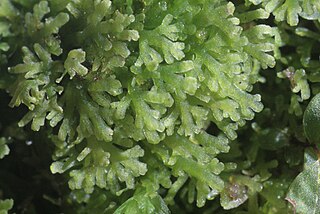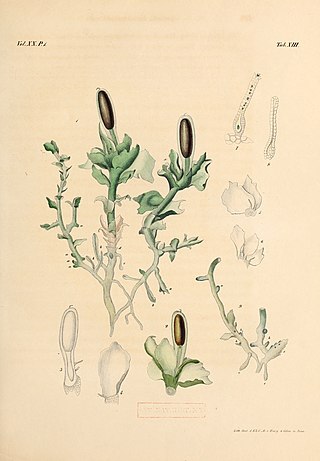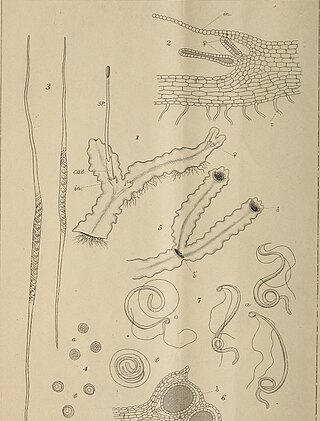
The Marchantiophyta are a division of non-vascular land plants commonly referred to as hepatics or liverworts. Like mosses and hornworts, they have a gametophyte-dominant life cycle, in which cells of the plant carry only a single set of genetic information.

Guadalupe Island is a volcanic island located 241 kilometres off the western coast of Mexico's Baja California Peninsula and about 400 km (200 nmi) southwest of the city of Ensenada in the state of Baja California, in the Pacific Ocean. The various volcanoes are extinct or dormant. In 2005 Guadalupe Island and its surrounding waters and islets were declared a biosphere reserve to restore its vegetation and to protect its population of marine mammals and birds. The island is a popular destination for great white shark cage diving. Guadalupe Island is inhabited only by scientists, military personnel operating a weather station, and a small group of seasonal fishermen. The island is mostly arid and has very little surface water.

Metzgeriales is an order of liverworts. The group is sometimes called the simple thalloid liverworts: "thalloid" because the members lack structures resembling stems or leaves, and "simple" because their tissues are thin and relatively undifferentiated. All species in the order have a small gametophyte stage and a smaller, relatively short-lived, spore-bearing stage. Although these plants are almost entirely restricted to regions with high humidity or readily available moisture, the group as a whole is widely distributed, and occurs on every continent except Antarctica.
Ptilidium californicum, the Pacific fuzzwort, is a rare liverwort of the western United States.

Cavicularia densa is the only species in the liverwort genus Cavicularia. The species was first described in 1897 by Franz Stephani, and is endemic to Japan, where it grows on fine moist soil.
Phycolepidozia exigua is a species of liverwort in the family Cephaloziellaceae. It was thought to be the only species in the genus until a new species from India, Phycolepidozia indica, was found in 2014. Phycolepidozia exigua is endemic to Dominica, where it is critically endangered. Its natural habitat is subtropical or tropical moist lowland forests.

Haplomitriopsida is a newly recognized class of liverworts comprising fifteen species in three genera. Recent cladistic analyses of nuclear, mitochondrial, and plastid gene sequences place this monophyletic group as the basal sister group to all other liverworts. The group thus provides a unique insight into the early evolution of liverworts in particular and of land plants in general.

Blasiales is an order of liverworts with a single living family and two species. The order has traditionally been classified among the Metzgeriales, but molecular cladistics suggests a placement at the base of the Marchantiopsida.

Makinoa crispata is the only species of liverwort in the genus Makinoa and family Makinoaceae. The genus Verdoornia was formerly included in this family, but has been transferred to the family Aneuraceae on the basis of recent cladistic analysis of genetic sequences.

Pleurozia is the only genus of liverworts in the family Pleuroziaceae, which is now classified in its own order Pleuroziales, but was previously included in a broader circumscription of the Jungermanniales. The genus includes twelve species, and as a whole is both physically distinctive and widely distributed.
Neotrichocoleaceae is a family of liverworts in order Ptilidiales. It is closely related to the genera Ptilidium and Herzogianthus.

Riella is a genus in the liverwort family Riellaceae, and includes about eighteen species. Plants in the genus are small and grow submerged in shallow temporary pools. Although the genus is widely distributed in the Northern Hemisphere, locating populations is often difficult. Its occurrence is sporadic and local, and the tiny plants are ephemeral. The ornamented spores remain viable for several years, allowing the plants to survive annual drying of their habitat. The plants are easily grown in laboratory cultures.
Hesperelaea is a plant genus with only one species, probably now extinct. Hesperelaea palmeri was found only on Guadalupe Island, a small island in the Pacific Ocean, part of the Mexican state of Baja California, about 400 km (250 mi) southwest of Ensenada. The last collection of the plant on the island was in 1875, so the species and the genus must now be presumed extinct. An intensive search for the plant in 2000 was unsuccessful.
Asterella gracilis is a thallose liverwort in the family Aytoniaceae.
Petalophyllum, or petalwort, is a genus of liverworts in the order Fossombroniales.
Petalophyllum americanum, common name petalwort, is a species of liverwort in the order Fossombroniales. It is endemic to the Gulf Coast of the United States in Arkansas, Louisiana, Mississippi, and Texas. It was first described as the European species Petalophyllum ralfsii in 1919, but a detailed study later showed that the North American form is a distinct species.

Asterella californica is a complex thallic liverwort in the phylum Marchantiophyta. A. californica often grows as colonies of flat rosettes of light green, rigid thalli, with undersides dark wine-red to nearly black. The receptacles are rounded, with four lobes each bearing a single sporangium sheathed by a white tattered skirt. A. californica is dioecious with separate male plants often intermingled with female plants. This species is found throughout California. See Distribution information below. Asterella californica is the commonest species of the three species of Asterella occurring in California; the other two species are A. bolanderi and A. palmeri.
Paul Leslie Redfearn Jr. (1926–2018) was an American professor of botany, specializing in mosses and liverworts. He was the president of the American Bryological and Lichenological Society from 1971 to 1973. He was the mayor of Springfield, Missouri from 1978 to 1981.

Ibervillea sonorae is a tuberous perennial plant in the Cucurbitaceae family known by the common names wereke, wareque, guarequi, and coyote melon. It is a highly variable species characterized by a large, succulent tuberous root, which in the dry sand of its native habitat resembles a gray, dust-covered boulder. Emerging from the root yearly are long, flexible liana-like shoots, which reach a length of three or more meters. This species is native to northwestern Mexico, being found in the states of Baja California, Baja California Sur, Sonora and Sinaloa.

Monoclea forsteri is one of the two species in the thallose liverwort family Monocleaceae. It is dioicous with the capsule dehiscing with a single longitudinal slit. Endemic and widely distributed throughout New Zealand, it is also the country's largest thalloid liverwort. Hooker described the species in 1820. The holotype is in the British Museum.













